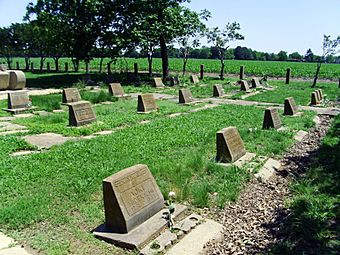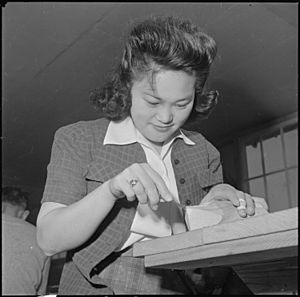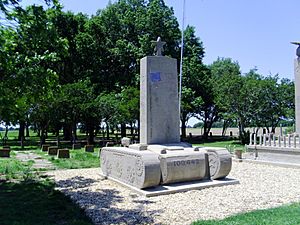Rohwer War Relocation Center facts for kids
|
Rohwer Relocation Center Cemetery
|
|

Rohwer Memorial Cemetery
|
|
| Location | Desha County, Arkansas, United States |
|---|---|
| Nearest city | Rohwer, Arkansas |
| Area | 1 acre (0.40 ha) |
| Architect | Kaneo Fujioka and Kay Horisawa |
| NRHP reference No. | 92001882 |
Quick facts for kids Significant dates |
|
| Added to NRHP | July 06, 1992 |
| Designated NHLD | July 6, 1992 |
The Rohwer War Relocation Center was a special camp in rural southeastern Arkansas during World War II. It was a place where many Japanese Americans were forced to live. The camp operated from September 18, 1942, to November 30, 1945.
At its busiest, the camp held 8,475 Japanese Americans. These people were made to leave their homes in California. Sometimes, people at the camp used the Japanese writing "朗和 (Rōwa)" to refer to Rohwer. Today, the Rohwer War Relocation Center Cemetery is still there. It was named a National Historic Landmark in 1992.
Contents
Building the Camp
The land for Rohwer was very large, about 10,161 acres (4,112 ha). The government bought this land in the 1930s. It was mostly empty until 1942. That's when the War Relocation Authority (WRA) took over. The WRA was in charge of the program that held Japanese Americans during the war.
The WRA planned to use this land for a camp. They wanted to hold people of Japanese heritage there. This included American citizens from the West Coast. These areas were seen as important for the war.
The governor of Arkansas, Homer Martin Adkins, did not want the camps at first. But he agreed after being told that armed guards would control the Japanese Americans. He was also promised that the people would leave Arkansas after the war. At this time, Arkansas had laws that treated Black citizens unfairly. These laws also stopped many Black citizens from voting.
Building the camp cost $4.8 million. The land was very swampy and had many trees. It was close to the Mississippi River. Workers had to clear a lot of land and drain water. This made building the camp very hard and slow. The camp was still being built when the first people arrived.
The camp ended up having offices, schools, and a hospital. It also had 36 living areas. Each area had twelve barracks, which were long buildings. These barracks were divided into small "apartments." There were also shared dining halls and bathrooms. A fence with barbed wire and guards surrounded the whole camp.
The person who designed the camp was Edward F. Neild. He also designed the nearby Jerome camp.
Life at Rohwer Camp
Rohwer camp opened on September 18, 1942. By March 1943, it held 8,475 people. Most of these people were forced from their homes and businesses. They came from Los Angeles or the San Joaquin Valley in California.
Many people at Rohwer were children who went to school. Most of these children were born in the U.S. About 2,000 students attended the camp's schools. The schools opened on November 9, 1942, after some delays.
Adults worked jobs in the camp. They worked for the camp administration, in the hospital, or in the schools. They also worked in the dining halls. Some worked on farms or did other jobs outside the camp. About 500 acres (200 ha) of the camp land was used for buildings. The rest of the land was used to grow over 100 different crops. These crops helped feed the people in the camp. The food budget was kept very low, about 37 cents per person per day. This was to avoid rumors that the WRA was "spoiling" Japanese Americans.
The Loyalty Questionnaire
In 1943, the WRA asked all adults in Rohwer and other camps to answer questions. This was called a "registration process." It was supposed to help people get permission to leave the camp for work or school. At first, only citizens could take it. Later, it was given to everyone. But soon, the main goal became checking how "loyal" Japanese Americans were.
This "loyalty questionnaire" made many people angry and confused. Two questions were especially difficult. One asked if they would volunteer for military service. This was hard because the government and army had treated them badly. The other asked if they would "give up their loyalty to the Emperor of Japan." Many people had never been loyal to the Emperor in the first place. The questions were confusing, and people did not trust why they were being asked.
The loyalty questionnaire was very unpopular at the Jerome camp, too. Jerome was about 27 miles south of Rohwer. Only 2 percent of men at Jerome and Rohwer joined the military. About 2,147 people from Jerome were called "disloyal." This was because they gave answers that the WRA did not like. These people were sent to a special camp called Tule Lake in California.
Because so many people left, and because of earlier problems with working conditions, the Jerome camp closed. It shut down at the end of June 1944. Many people from Jerome were then moved to Rohwer. Rohwer was one of the last WRA camps to close. It shut down on November 30, 1945.
Rohwer Today
Today, the biggest building left from the camp is the high school gym. It was used by the local school until 2004. The tallest thing left is the smokestack from the hospital's incinerator. Neither of these buildings has signs explaining their history.
The train tracks that brought people and supplies to the camp are still there. They look abandoned now. Some of the tracks are from World War II or even earlier. These tracks also served the Jerome camp, which was about 30 miles (48.3 km) southwest of Rohwer.
You can still see many old building foundations and walkways. Local people still use some of them. Trees planted by the people who lived there have grown very tall.
The camp cemetery is the only part of the internment center that is still clearly marked. It was named a National Historic Landmark in 1992. The cemetery has a monument for Japanese American soldiers who died in the war. It also has a monument for those who died at the camp. The whole camp site was added to the National Register of Historic Places in 1974.
A concrete memorial shaped like a tank stands at the cemetery. It honors Japanese Americans who fought for the U.S. during World War II. From this camp, 581 men joined the U.S. Army. They either volunteered or were drafted into famous units like the 100th Infantry Battalion and the 442nd Regimental Combat Team. Thirty-one men from Rohwer died in battle. Their names are on the memorial and another one nearby.
The National Park Service says that the cemetery's grave markers are getting old and damaged. The cemetery is about 0.5 miles (0.8 km) west of State Route 1. It is about 12 miles (19.3 km) northeast of McGehee, Arkansas. Signs show the way from the highway to the cemetery, where you can park.
A Place to Remember
The Rohwer War Relocation Center site is now a special place managed by Arkansas State University. It has a memorial, the camp cemetery, and signs with information. There are also audio stations where you can listen to stories.
The Japanese American Internment Museum opened in nearby McGehee, Arkansas in 2013. This museum tells the history of the Rohwer camp. It has a film, stories from people who lived there, photos, and personal items.
Famous People from Rohwer
Many notable people were held at the Rohwer camp. Here are a few:
- Ruth Asawa (1926–2013), a Japanese American sculptor.
- Takayo Fischer (born 1932), an American actress for stage, film, and TV. She was also at the Jerome camp.
- Aiko Herzig-Yoshinaga (1924–2018), a political activist. She was also at the Manzanar and Jerome camps.
- Eddie Imazu (1897–1979), an art director and production designer. He was also at the Jerome camp.
- Sumako Hamaguchi (1918–2023), a kabuki dancer.
- Jim Ishida (born 1943), an actor known for his role in Back to the Future Part II.
- Janice Mirikitani (1941–2021), a poet. She helped start the Glide Foundation, which helps people in need in San Francisco.
- Rose Ochi (1938–2020), a Japanese American lawyer and civil rights activist.
- Haruko Sugi (1915–2012), a language translator.
- Henry Sugimoto (1900–1990), a Japanese-born artist. He was also at the Jerome camp.
- George Takei (born 1937), an activist, author, and actor. He is famous for playing Lieutenant Hikaru Sulu in Star Trek. His family was later moved to Tule Lake War Relocation Center because his parents did not "pass" the loyalty questionnaire.
- Michiko Toyama (1908–2000), a composer.
- Taitetsu Unno (1930–2014), a Buddhist scholar and author. He was also at the Tule Lake War Relocation Center.
- Grayce Uyehara (1919–2014), a Japanese-American social worker and activist.






